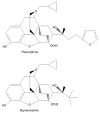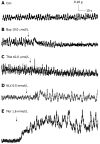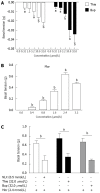Effect of thienorphine on intestinal transit and isolated guinea-pig ileum contraction
- PMID: 23539497
- PMCID: PMC3602504
- DOI: 10.3748/wjg.v19.i9.1444
Effect of thienorphine on intestinal transit and isolated guinea-pig ileum contraction
Abstract
Aim: To evaluate the effect of thienorphine on small intestinal transit in vivo and on guinea-pig ileum (GPI) contraction in vitro.
Methods: The effects of thienorphine on intestinal transit were examined in mice and in isolated GPI. Buprenorphine and morphine served as controls. The distance traveled by the head of the charchol and the total length of the intestine were measured in vivo. Gastrointestinal transit was expressed as a percentage of the distance traveled by the head of the marker relative to the total length of the small intestine. The isolated GPI preparations were connected to an isotonic force transducer and equilibrated for at least 1 h before exposure to drugs. Acetylcholine was used for muscle stimulation.
Results: Thienorphine (0.005-1.0 mg/kg, ig) or buprenorphine (0.005-1.0 mg/kg, sc) dose-dependently significantly inhibited gut transit compared with saline. Thienorphine inhibited gut transit less than buprenorphine. The maximum inhibition by thienorphine on the intestinal transit was 50%-60%, whereas the maximum inhibition by morphine on gut transit was about 100%. Thienorphine also exhibited less inhibition on acetylcholine-induced contraction of GPI, with a maximum inhibition of 65%, compared with 93% inhibition by buprenorphine and 100% inhibition by morphine. Thienorphine induced a concentration-dependent decrease in the basal tonus of spontaneous movement of the GPI, the effect of which was weaker than that with buprenorphine. The duration of the effect of thienorphine on the GPI was longer than that with buprenorphine.
Conclusion: Thienorphine had less influence, but a longer duration of action on GPI contraction and moderately inhibited intestinal transit.
Keywords: Buprenorphine; Contraction; Guinea-pig ileum; Gut transit; Thienorphine.
Figures







Similar articles
-
Effects of thienorphine on contraction of the guinea pig sphincter of Oddi, choledochus and gall bladder.Eur J Pharmacol. 2014 Aug 15;737:22-8. doi: 10.1016/j.ejphar.2014.04.044. Epub 2014 May 14. Eur J Pharmacol. 2014. PMID: 24830319
-
Multiple mechanisms underlying the long duration of action of thienorphine, a novel partial opioid agonist for the treatment of addiction.CNS Neurosci Ther. 2014 Mar;20(3):282-8. doi: 10.1111/cns.12210. Epub 2013 Dec 16. CNS Neurosci Ther. 2014. PMID: 24330593 Free PMC article.
-
Effects of thienorphine on the contraction of isolated ureter and bladder of guinea pigs.Eur J Pharmacol. 2016 Oct 15;789:144-151. doi: 10.1016/j.ejphar.2016.07.029. Epub 2016 Jul 18. Eur J Pharmacol. 2016. PMID: 27445237
-
Comparison of effect of [D-Arg2,Sar4]-dermorphin (1-4) and morphine on mouse small intestinal transit and electrically evoked contraction of guinea pig ileum.Methods Find Exp Clin Pharmacol. 1998 Apr;20(3):193-8. Methods Find Exp Clin Pharmacol. 1998. PMID: 9646281
-
[Characteristics and Functional Roles of Opioids Originally Present in Vivo].Yakugaku Zasshi. 2016;136(4):591-605. doi: 10.1248/yakushi.15-00265. Yakugaku Zasshi. 2016. PMID: 27040344 Review. Japanese.
Cited by
-
Novel mixed NOP/MOP agonist BU08070 alleviates pain and inhibits gastrointestinal motility in mouse models mimicking diarrhea-predominant irritable bowel syndrome symptoms.Eur J Pharmacol. 2014 Aug 5;736:63-9. doi: 10.1016/j.ejphar.2014.04.038. Epub 2014 May 6. Eur J Pharmacol. 2014. PMID: 24815321 Free PMC article.
-
What Do We Know about Opioids and the Kidney?Int J Mol Sci. 2017 Jan 22;18(1):223. doi: 10.3390/ijms18010223. Int J Mol Sci. 2017. PMID: 28117754 Free PMC article. Review.
-
Opioid-induced constipation: rationale for the role of norbuprenorphine in buprenorphine-treated individuals.Subst Abuse Rehabil. 2016 Jun 14;7:81-6. doi: 10.2147/SAR.S100998. eCollection 2016. Subst Abuse Rehabil. 2016. PMID: 27366109 Free PMC article. Review.
-
Methyl-orvinol-Dual activity opioid receptor ligand inhibits gastrointestinal transit and alleviates abdominal pain in the mouse models mimicking diarrhea-predominant irritable bowel syndrome.Pharmacol Rep. 2017 Apr;69(2):350-357. doi: 10.1016/j.pharep.2016.12.001. Epub 2016 Dec 5. Pharmacol Rep. 2017. PMID: 28187396 Free PMC article.
References
-
- Mendelson J, Upton RA, Everhart ET, Jacob P, Jones RT. Bioavailability of sublingual buprenorphine. J Clin Pharmacol. 1997;37:31–37. - PubMed
-
- Schuh KJ, Johanson CE. Pharmacokinetic comparison of the buprenorphine sublingual liquid and tablet. Drug Alcohol Depend. 1999;56:55–60. - PubMed
-
- Heel RC, Brogden RN, Speight TM, Avery GS. Buprenorphine: a review of its pharmacological properties and therapeutic efficacy. Drugs. 1979;17:81–110. - PubMed
-
- Liu H, Zhong BH, Liu CH, Wu B, Gong ZH. Synthesis, crystal structure and pharmacological study of N-cyclopropylmethyl-7- -6,14-endo-ethanotetrahydro-oripavine. Acta Chim Slov. 2005;52:80–85.
-
- Yu G, Yue YJ, Cui MX, Gong ZH. Thienorphine is a potent long-acting partial opioid agonist: a comparative study with buprenorphine. J Pharmacol Exp Ther. 2006;318:282–287. - PubMed
Publication types
MeSH terms
Substances
LinkOut - more resources
Full Text Sources
Other Literature Sources

